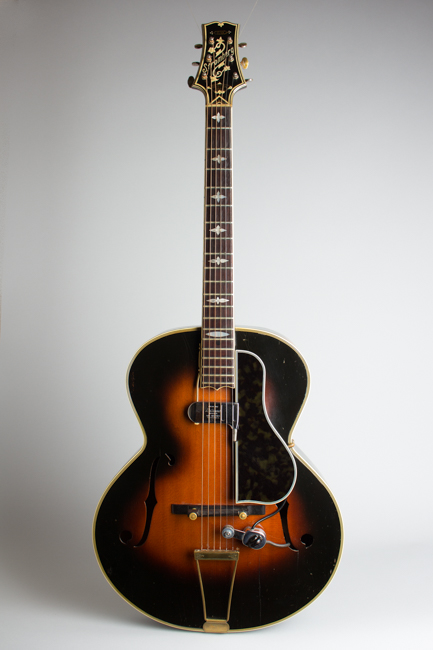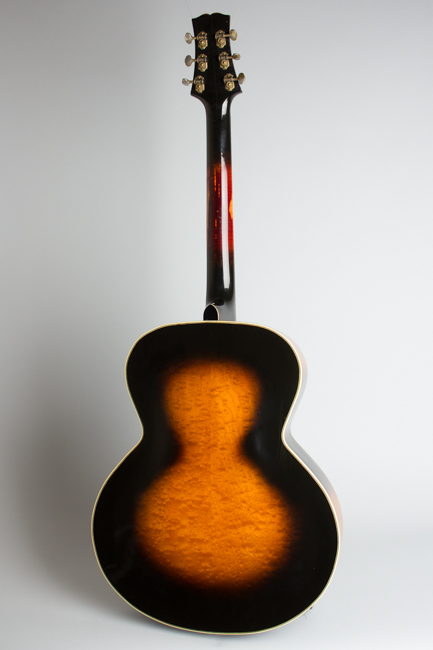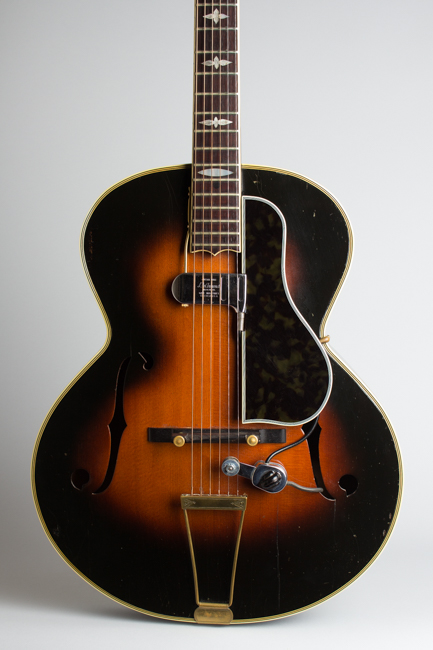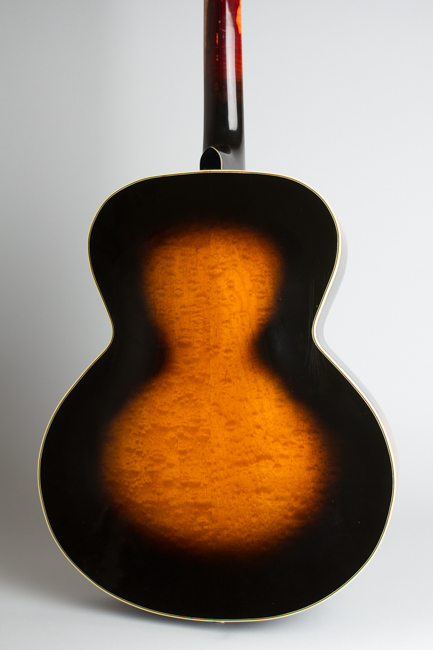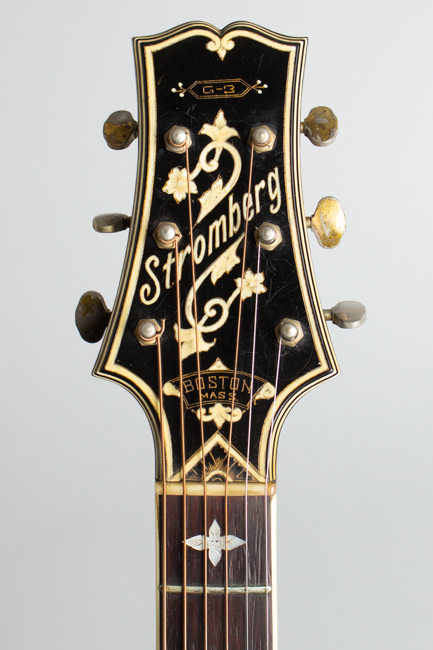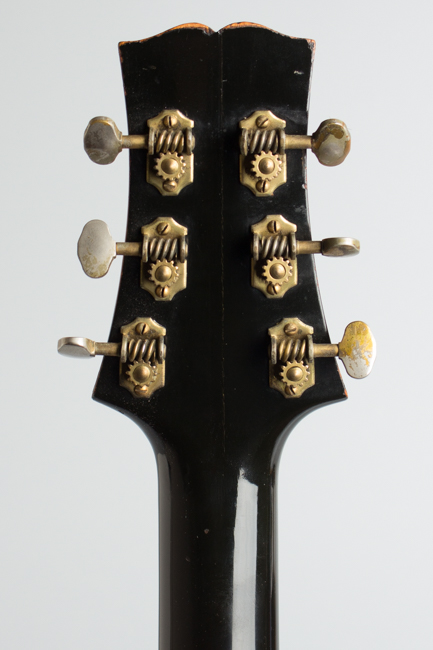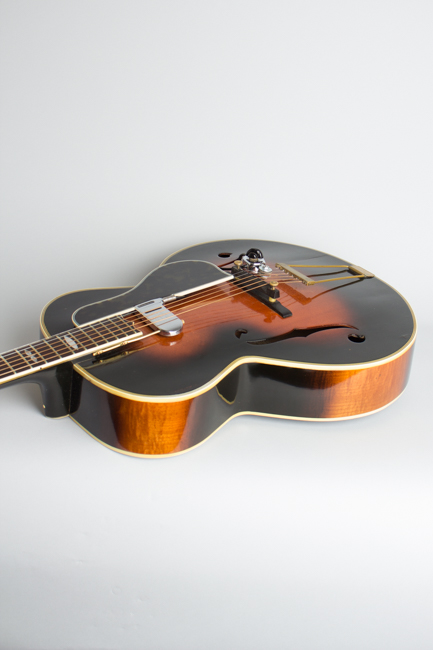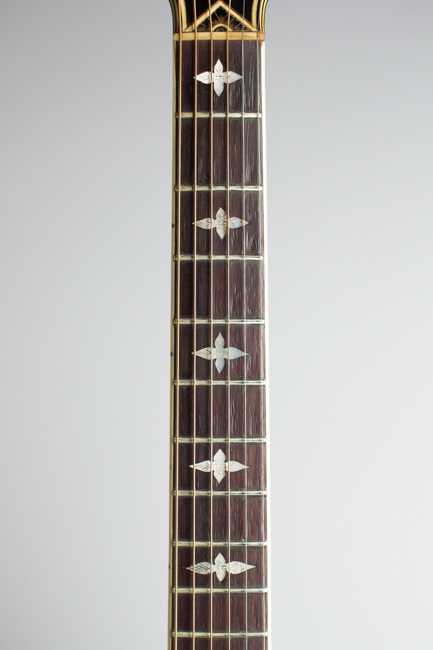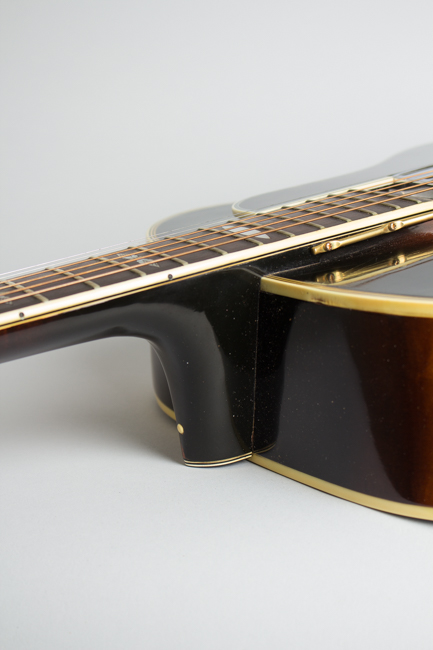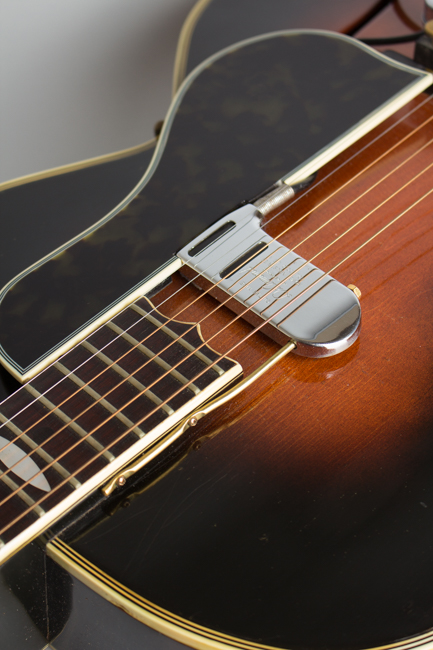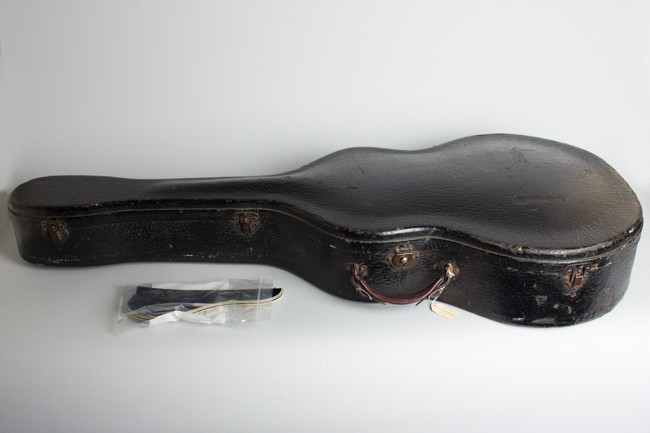Stromberg Model G-3 Arch Top Acoustic Guitar , c. 1935
This item has been sold.
Item # 7495
Prices subject to change without notice.
Stromberg Model G-3 Model Arch Top Acoustic Guitar, c. 1935, made in Boston, Mass., serial # 461, sunburst lacquer finish, maple back and sides, spruce top; laminated maple neck with ebony fingerboard, original black hard shell case.
The father-and-son team of Charles and Elmer Stromberg of Boston have entered the annals of American lutherie as one of the great names in 20th century guitar building. Elmer, the son, was the primary guitar artisan of the business, and some of his handmade creations are considered among the greatest of all arch-top instruments. In the 1940s his handmade Master 400 with a huge 19" wide body and single diagonal top brace was hailed as the greatest of all acoustic big-band guitars.
This Stromberg guitar dates to an earlier period, around the mid 1930s. At this point the designs were somewhat more primitive, although always very finely made. This is a model G-3, the second fanciest of the guitars of this period and quite a flashy instrument in its own right.
The body is 16 1/2" wide and has heavy 5-ply binding on the top and 3-ply on the back. The top itself has segmented f-holes (like an early Masterbilt Epiphone) and a dark sunburst in something of a "figure 8" pattern. The adjustable ebony bridge is a unique affair with large knurled wheels mounted above the saddle, a small work of art unto itself. The tailpiece is a simple trapeze design but beautifully engraved.
The neck of this guitar is where the Strombergs' artistry really shines. By this point they had been building fancy banjos for many years, and many design elements are similar on this 6-string creation. The ebony fingerboard is inlaid with engraved, shaped pearl inlay and triple side-bound. The neck itself is of 5-ply laminate curly maple construction finished in a dark sunburst.
The piece de resistance is the headstock, a multi-laminate festival of cut-through and gold-detailed Celluloid, dressed away at the edge to appear multi-bound. The floral engraved pattern on the face sets off the diagonal "Stromberg" logo and the legends "Boston, Mass." and "G-3".
The construction of the earlier Stromberg guitars is most unusual -- the top is not made from a block and carved into an arch, but a piece of solid spruce bent over shaped bracing to achieve the same effect. The back is a pressed laminate, which is also most unusual for a small shop. By the early 1940s Elmer Stromberg began carving tops like Gibson, Epiphone, and D'Angelico, but all earlier Stromberg guitars are built in this hybrid manner.
The sound of these 1930s guitars is not as powerful as the later Strombergs, but still remarkably full-sounding and sweeter than many similar instruments. Only the Larson Brothers in Chicago built arch-tops with similar top construction, and theirs tend to have more of a "flat-top" flavor to the sound.
This is a very fine-sounding and playing guitar in the purely acoustic mode, but it is currently fitted with a very early DeArmond "Guitar Mike" pickup from the 1940s. This makes for a fantastic-sounding acoustic-electric instrument, with the classic 1940s jazz/swing/jump blues character in spades.
The electric equipment is removable if desired, although it would need to be un-wired from the endpin jack to do so. The original pickguard was not cut to accommodate the pickup; a reproduction was fitted in its place.
A Charles Stromberg & Son business card is glued inside the back of this guitar, giving the historic 40 Hanover Street address and with the serial number noted by hand on the bottom edge.
All Stromberg guitars are rare; many published estimates have put the number made at around 600, but more detailed analysis of existing instruments shows the serial numbers appear to start around 300, and so the total may be less than 350 guitars of all types ever built. Each is a unique gem; even this early model with its (in retrospect) somewhat quizzical design elements is enchanting and a pure pleasure to play.
Overall length is 41 1/4 in. (104.8 cm.), 16 1/2 in. (41.9 cm.) wide at lower bout, and 3 7/16 in. (8.7 cm.) in depth, measured at side of rim. Scale length is 25 1/4 in. (641 mm.). Width of nut is 1 11/16 in. (43 mm.).
This guitar remains in overall very good condition for its age. A very fine-playing guitar with the added floating pickup as noted above and some old repairs. There are two spruce grain cracks to the top on the treble side lower bout, both well-sealed but visible. A third very small grain crack is just at the front edge of the bass side f-hole.
There are some dings, dents, and scrapes to the finish, but not a lot of play wear except to the back of the neck. That area has been oversprayed, and there is some older finish wear through the original dark lacquer which is visible under the newer clear topcoat.
The neck appears to have possibly been reset, but if so it is a very clean job. There is one very small isolated spot of binding shrinkage on the top edge not far from the bass side of the heel; the rest of the celluloid shows no issues at all.
There are some scratches to the headstock face, but the engraved plastic shows no deterioration. The original early Grover Sta-Tite tuners are intact and functional. The gold-plated parts do show some fairly heavy wear -- the bulk of the tailpiece is down to unplated brass, which actually looks fine.
The frets and fingerboard show some playing wear (the frets appear original), but the guitar still plays extremely well. The engraved fingerboard inlays show some slight loss and some of the dark fill is worn away, as is common. The very heavy original laminated celluloid pickguard is still intact in the case; it was not harmed during the pickup installation. The one in use now is a very good repro.
The only alterations are two small holes in the bass side of the neck for the bracket mounting and an added endpin jack under the tailpiece. These could be reversed if desired, but the guitar sounds so good as it is we have left it set up for acoustic/electric play. The original case is still intact; it has been painted over black, but still is in fully functional condition. Excellent - Condition.
The father-and-son team of Charles and Elmer Stromberg of Boston have entered the annals of American lutherie as one of the great names in 20th century guitar building. Elmer, the son, was the primary guitar artisan of the business, and some of his handmade creations are considered among the greatest of all arch-top instruments. In the 1940s his handmade Master 400 with a huge 19" wide body and single diagonal top brace was hailed as the greatest of all acoustic big-band guitars.
This Stromberg guitar dates to an earlier period, around the mid 1930s. At this point the designs were somewhat more primitive, although always very finely made. This is a model G-3, the second fanciest of the guitars of this period and quite a flashy instrument in its own right.
The body is 16 1/2" wide and has heavy 5-ply binding on the top and 3-ply on the back. The top itself has segmented f-holes (like an early Masterbilt Epiphone) and a dark sunburst in something of a "figure 8" pattern. The adjustable ebony bridge is a unique affair with large knurled wheels mounted above the saddle, a small work of art unto itself. The tailpiece is a simple trapeze design but beautifully engraved.
The neck of this guitar is where the Strombergs' artistry really shines. By this point they had been building fancy banjos for many years, and many design elements are similar on this 6-string creation. The ebony fingerboard is inlaid with engraved, shaped pearl inlay and triple side-bound. The neck itself is of 5-ply laminate curly maple construction finished in a dark sunburst.
The piece de resistance is the headstock, a multi-laminate festival of cut-through and gold-detailed Celluloid, dressed away at the edge to appear multi-bound. The floral engraved pattern on the face sets off the diagonal "Stromberg" logo and the legends "Boston, Mass." and "G-3".
The construction of the earlier Stromberg guitars is most unusual -- the top is not made from a block and carved into an arch, but a piece of solid spruce bent over shaped bracing to achieve the same effect. The back is a pressed laminate, which is also most unusual for a small shop. By the early 1940s Elmer Stromberg began carving tops like Gibson, Epiphone, and D'Angelico, but all earlier Stromberg guitars are built in this hybrid manner.
The sound of these 1930s guitars is not as powerful as the later Strombergs, but still remarkably full-sounding and sweeter than many similar instruments. Only the Larson Brothers in Chicago built arch-tops with similar top construction, and theirs tend to have more of a "flat-top" flavor to the sound.
This is a very fine-sounding and playing guitar in the purely acoustic mode, but it is currently fitted with a very early DeArmond "Guitar Mike" pickup from the 1940s. This makes for a fantastic-sounding acoustic-electric instrument, with the classic 1940s jazz/swing/jump blues character in spades.
The electric equipment is removable if desired, although it would need to be un-wired from the endpin jack to do so. The original pickguard was not cut to accommodate the pickup; a reproduction was fitted in its place.
A Charles Stromberg & Son business card is glued inside the back of this guitar, giving the historic 40 Hanover Street address and with the serial number noted by hand on the bottom edge.
All Stromberg guitars are rare; many published estimates have put the number made at around 600, but more detailed analysis of existing instruments shows the serial numbers appear to start around 300, and so the total may be less than 350 guitars of all types ever built. Each is a unique gem; even this early model with its (in retrospect) somewhat quizzical design elements is enchanting and a pure pleasure to play.
Overall length is 41 1/4 in. (104.8 cm.), 16 1/2 in. (41.9 cm.) wide at lower bout, and 3 7/16 in. (8.7 cm.) in depth, measured at side of rim. Scale length is 25 1/4 in. (641 mm.). Width of nut is 1 11/16 in. (43 mm.).
This guitar remains in overall very good condition for its age. A very fine-playing guitar with the added floating pickup as noted above and some old repairs. There are two spruce grain cracks to the top on the treble side lower bout, both well-sealed but visible. A third very small grain crack is just at the front edge of the bass side f-hole.
There are some dings, dents, and scrapes to the finish, but not a lot of play wear except to the back of the neck. That area has been oversprayed, and there is some older finish wear through the original dark lacquer which is visible under the newer clear topcoat.
The neck appears to have possibly been reset, but if so it is a very clean job. There is one very small isolated spot of binding shrinkage on the top edge not far from the bass side of the heel; the rest of the celluloid shows no issues at all.
There are some scratches to the headstock face, but the engraved plastic shows no deterioration. The original early Grover Sta-Tite tuners are intact and functional. The gold-plated parts do show some fairly heavy wear -- the bulk of the tailpiece is down to unplated brass, which actually looks fine.
The frets and fingerboard show some playing wear (the frets appear original), but the guitar still plays extremely well. The engraved fingerboard inlays show some slight loss and some of the dark fill is worn away, as is common. The very heavy original laminated celluloid pickguard is still intact in the case; it was not harmed during the pickup installation. The one in use now is a very good repro.
The only alterations are two small holes in the bass side of the neck for the bracket mounting and an added endpin jack under the tailpiece. These could be reversed if desired, but the guitar sounds so good as it is we have left it set up for acoustic/electric play. The original case is still intact; it has been painted over black, but still is in fully functional condition. Excellent - Condition.
